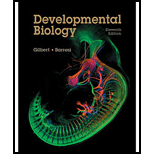
Concept explainers
To review:
The nature of processing of chordin and BMP pathways in flies and vertebrates, and the mechanism by which chordin-BMP axis allow the regulation of the same pattern of embryonic axis in both smaller and larger embryo.
Introduction:
The dorso-ventral patterning of the bilaterally symmetrical organism is controlled by the chordin-BMP pathway. This pathway forms the signaling centers at antipodal positions and despite of being conserved during evolution, the component perform different functions. The pattern forming reactions are responsible for the generation of signaling centers which are self regulated and acts as a organizer to form the primary embryonic axes. Basically, two organizer acts at each terminal position, one acts as primary system and this system helps in establishing the secondary system at a distance. A number of related models helps in describing the dorso-ventral pattern formation in different phyla, chordin and BMP pathway is one of the important model for this signalling pattern.
Explanation of Solution
Bone morpogenetic proteins (BMPs) are considered as a long-ranging inhibitory component which restrict the size of the organizer, wheras the chordin acts as an activator and both are expressed in partially overlapping region. The ectoderm is induced to be the epidermis in the presence of BMPs, while the inhibition of BMPs leads to the development of the nervous tisue from the ectoderm. To fullfill this requirement organizer produces the BMP inhibiting molecules. The three primary BMP inhibitors are Chordin, Noggin and Follistatin. The gene
expressing these proteins are considered as one of the most important genes activated by the Smad2 and Siamois/Twin. Norrin is the fourth inhibitor helps in blockage of BMP in dorsal ectoderm. Chordin mRNA has been localized in dorsal blastopore lip and in notocord at the later stage, it helps in inducing secondary nervous system. In different organism BMP-chordin pathway bears its homologue like Decapentaplegic (Dpp) is a BMP homologue and BMP antagonist short gastrulation (Sog) is a homologue of chordin. In Drosophila embryo chordin produces ventral nervous system and in Xenopus embryo it is localized at dorsal site. In both of these cases sog/chordin helps in the specification of neural tissue by blocking the adverse effects Dpp/BMP4.
Thus it is concluded that in both flies and vertebrates chordin and BMP pathway follows a closely related pattern involving BMP inhibition by chordin and few other protein molecules to induce the nervous system from the ectoderm and also regulate the embryonic axis pattern formation.
Want to see more full solutions like this?
Chapter 11 Solutions
Developmental Biology
- Describe two different gene regulation mechanisms involving methylationarrow_forwardWhat is behavioral adaptarrow_forward22. Which of the following mutant proteins is expected to have a dominant negative effect when over- expressed in normal cells? a. mutant PI3-kinase that lacks the SH2 domain but retains the kinase function b. mutant Grb2 protein that cannot bind to RTK c. mutant RTK that lacks the extracellular domain d. mutant PDK that has the PH domain but lost the kinase function e. all of the abovearrow_forward
- Explain how the hormones of the glands listed below travel around the body to target organs and tissues : Pituitary gland Hypothalamus Thyroid Parathyroid Adrenal Pineal Pancreas(islets of langerhans) Gonads (testes and ovaries) Placentaarrow_forwardWhat are the functions of the hormones produced in the glands listed below: Pituitary gland Hypothalamus Thyroid Parathyroid Adrenal Pineal Pancreas(islets of langerhans) Gonads (testes and ovaries) Placentaarrow_forwardDescribe the hormones produced in the glands listed below: Pituitary gland Hypothalamus Thyroid Parathyroid Adrenal Pineal Pancreas(islets of langerhans) Gonads (testes and ovaries) Placentaarrow_forward
 Biology: The Dynamic Science (MindTap Course List)BiologyISBN:9781305389892Author:Peter J. Russell, Paul E. Hertz, Beverly McMillanPublisher:Cengage Learning
Biology: The Dynamic Science (MindTap Course List)BiologyISBN:9781305389892Author:Peter J. Russell, Paul E. Hertz, Beverly McMillanPublisher:Cengage Learning Biology (MindTap Course List)BiologyISBN:9781337392938Author:Eldra Solomon, Charles Martin, Diana W. Martin, Linda R. BergPublisher:Cengage Learning
Biology (MindTap Course List)BiologyISBN:9781337392938Author:Eldra Solomon, Charles Martin, Diana W. Martin, Linda R. BergPublisher:Cengage Learning Anatomy & PhysiologyBiologyISBN:9781938168130Author:Kelly A. Young, James A. Wise, Peter DeSaix, Dean H. Kruse, Brandon Poe, Eddie Johnson, Jody E. Johnson, Oksana Korol, J. Gordon Betts, Mark WomblePublisher:OpenStax College
Anatomy & PhysiologyBiologyISBN:9781938168130Author:Kelly A. Young, James A. Wise, Peter DeSaix, Dean H. Kruse, Brandon Poe, Eddie Johnson, Jody E. Johnson, Oksana Korol, J. Gordon Betts, Mark WomblePublisher:OpenStax College Biology: The Unity and Diversity of Life (MindTap...BiologyISBN:9781305073951Author:Cecie Starr, Ralph Taggart, Christine Evers, Lisa StarrPublisher:Cengage Learning
Biology: The Unity and Diversity of Life (MindTap...BiologyISBN:9781305073951Author:Cecie Starr, Ralph Taggart, Christine Evers, Lisa StarrPublisher:Cengage Learning Biology 2eBiologyISBN:9781947172517Author:Matthew Douglas, Jung Choi, Mary Ann ClarkPublisher:OpenStax
Biology 2eBiologyISBN:9781947172517Author:Matthew Douglas, Jung Choi, Mary Ann ClarkPublisher:OpenStax Understanding Nutrition (MindTap Course List)Health & NutritionISBN:9781337392693Author:Eleanor Noss Whitney, Sharon Rady RolfesPublisher:Cengage Learning
Understanding Nutrition (MindTap Course List)Health & NutritionISBN:9781337392693Author:Eleanor Noss Whitney, Sharon Rady RolfesPublisher:Cengage Learning





